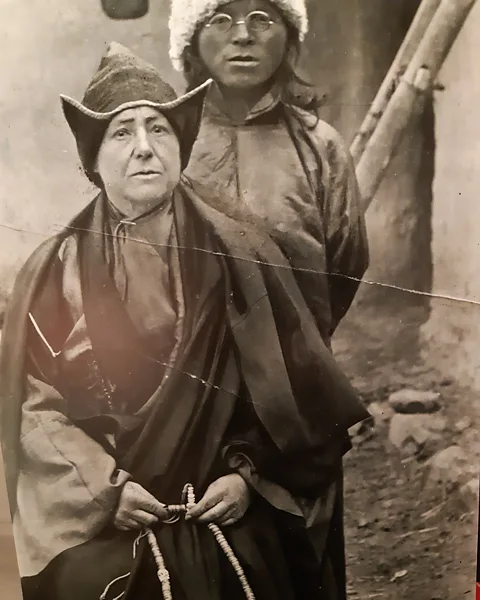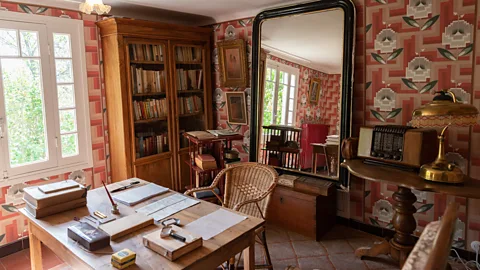A trailblazing journey to the forbidden city of Lhasa
 Getty Images
Getty ImagesIn 1924, French-born Alexandra David-Neel became the first European woman to set foot in the Tibetan city of Lhasa. Now, 100 years on, her story is as relevant as ever.
Since Roman times, travellers have flocked to Digne-les-Bains in lavender-fragranced northern Provence for its natural springs. Yet, even if her legs were understandably weary after 14 years of intrepid travels across Asia, for Alexandra David-Néel it was not the restorative powers of its spa waters that called her to the French town in 1928. Instead, the setting transported her back to her beloved Tibet, a country that, four years earlier in 1924, at the age of 55, she had crossed by foot disguised as a pilgrim to become the first European woman to enter the forbidden city of Lhasa.
Born in Paris, David-Néel had spent the three years since returning to France in 1925 touring the country and hosting talks to establish her status as an expert in Tibet and Buddhist philosophy. Home was a temporary one: a rented villa in Toulon, a port city to the east of Marseille on the Mediterranean coast, where she wrote in vivid detail a rollicking recount of her adventure: Voyage d'une Parisienne à Lhassa (translated into English with the title My Journey to Lhasa).
With the income from her writing, David-Néel was able to look for a place to call her own. When a real estate agent took her 150km inland to Digne-les-Bains, and she took in the mountains-meet-river landscape, it was as if she had found the closest thing to Tibet in her homeland. She purchased a small cottage on the outskirts of town on a hectare and a half of land, naming it "Samten Dzong", or "Residence of the Reflection".
Recently restored to how it was when she lived there, Maison Alexandra David-Néel (as the property is now known) is open to visitors to learn more about the life and adventures of this pioneering woman. And 2024 is one of extra celebration, as it marks the centenary of her voyage to Lhasa, with two temporary exhibitions: a photographic study of David-Néels journey to Lhasa (until 31 March) and a collection of textile works inspired by David-Néels travels by Franco-Iranian artist Golnaz Payani (until 19 May).
Tenzin Gyatso, the 14th Dalai Lama, has called David-Néel "an enthusiastic Buddhist, the first to introduce the real Tibet to the West". Indeed, her body of work – more than 30 books on Buddhism and travel – has been credited with shaping Western understanding of spirituality and Eastern religion. She has been credited with influencing artists like Beat Generation writer like Jack Kerouac.
Yet, as her biographer Jeanne Mascolo de Filippis said, "She continues to not be known".
 AD04
AD04"Even when I speak to those around me, and tell them I wrote a book about her, there are people who still ask who she was," the Paris-based author and filmmaker explained.
David-Néel was born as Louise Eugénie Alexandrine Marie David in 1868 to a French father and a Belgian mother. She acknowledged her restlessness from a young age. "Ever since I was five years old, a tiny precocious child of Paris... I craved to go beyond the garden gate, to follow the road that passed it by, and to set out for the Unknown," she wrote in the preface to My Journey to Lhasa.
As a young adult, she flitted between the UK, Italy, France and Belgium, frequenting anarchist and feminist circles. At 21, after devouring books in the library of the Theosophical Society in Paris, she converted to Buddhism. She travelled to India for the first time in 1894 to study Sanskrit.
After her return, she toggled between journalism and life on stage as an opera singer and even worked at the casino in Tunis; it was in the Tunisian capital where, in 1904, she married Philippe Néel, a French engineer working on the railroad. Theirs would be an unconventional marriage, one spent apart, but they remained wedded until he died in 1941.
"She had many lives, each with very different faces, but they all reflected a grand modernity for her time," explained Nadine Gomez-Passamar, head curator of the Musées de la Ville de Digne-les-Bains, the museum service responsible for Maison Alexandra David-Néel.
For Gomez-Passamar, what makes David-Néel even more remarkable is that she didn't hail from a bourgeois or moneyed background. "Everything she achieved, she did with very limited means," she said.
 AD04
AD04In 1911, David-Néel set off on what would become her greatest voyage: a 14-year-long odyssey through Japan, Korea, China, Mongolia, India and Tibet that culminated in her four-month journey to Lhasa. She learned Tibetan at the instruction of the 13th Dalai Lama (an audience that made her the first Western woman to have been received by any Dalai Lama), studied texts in Tibetan monasteries, and meditated in a solitary mountain hermitage in the Himalayas of the Kingdom of Sikkim (today a state in India) for 18 months. It was in Sikkim that she would meet a young monk called Aphur Yongden who became her travel companion and eventually her adopted son.
All the while, the core of Tibet, including the capital Lhasa, was closed to all foreigners, save for the British, who had negotiated control of trade routes. This didn't faze David-Néel, who wrote in My Journey to Lhasa that she had taken an oath to "reach Lhasa and show what the will of a woman can achieve".
As she recounts in her memoir, she navigated brigands and border controls, travelling mainly under the cover of night, her face darkened by cooking pot soot and wearing yak hair pigtails as she played the role of Yongden's mother. Her performing background came in handy. "She liked to dress up," said Mascolo de Filippis.
 AD04
AD04But success in Lhasa, where fellow adventurers and missionaries had failed, was due to more than her acting skills. "She was initiated by masters, so her purpose was already more legitimate. And, she knew the terrain very, very well – after all, she had spent years living [in Tibet]," said Mascolo de Filippis.
She remained in Lhasa for two months, finally setting foot inside the towering Potala Palace, the winter residence of the Dalai Lama, before leaving the city with Yongden to start on the long journey back to France.
David-Néel settled into Provençal life in the house she had gradually extended, including constructing a tower at the heart of it for meditation, topped with a gyältsän, an emblem of Tibetan victory. In 1937, she returned to Asia for a nine-year voyage that would be her last, selling off some of the land around Samten Dzong to finance her travels.
 AD04
AD04Yongden, her adopted son, died in 1955. David-Néel lived to 100, passing just before her 101st birthday in 1969. In her will, she left Samten Dzong and the rights to her works to the town of Digne-les-Bains, but specified that her secretary and companion, Marie-Madeleine Peyronnet, could remain living in the house. "Peyronnet started to transform it to her tastes and the style of the period, the '70s," said Gomez-Passamar. "She then lived in a villa that she constructed a little bit higher up."
When the municipality of Digne-les-Bains decided to renovate the house to its original style, it turned to Gomez-Passamar. "From the archives, we were able to reconstitute all the rooms that had been transformed," she explained. By 2023, Samten Dzong's faithful renovation was complete, down to the small vegetable patch with plump tomatoes in summer and a rose garden – David-Néel's favourite flower.
David-Néel herself planted the lime tree that stands at the entrance to the property, now a listed historical monument that's wonderfully eclectic and full of mementoes from her travels. The visitor experience starts in Peyronnet's villa, now a museum, that traces the chronology of David-Neel's life and exploits through a collection of photographs, correspondence and travel objects explained in both French and English.
CARBON COUNT
The travel emissions it took to report this story were 0.05 metric tons of CO2e. Find out more about how we calculated this figure here.
The visit continues with a guided tour (in French only and reserved by phone in advance) through Samten Dzong, past the ground floor sitting room styled like a cabinet of curiosities with souvenirs such as Tibetan manuscripts, carefully wrapped in material, clay tsatsa (small votive offerings) and small bells called ghanta. It was here where she welcomed journalists, editors and fellow writing friends, including British author Lawrence Durrell.
There's something particularly poignant about the simple single beds in her and Yongden's bedrooms and the plain wooden desk in her office. After four months spent sleeping under rudimentary tents on Tibetan mountains as they inched closer to Lhasa, their existence in Digne-les-Bains was luxurious by comparison, but still very modest.
One hundred years on from her trailblazing travels in Tibet, David-Néel's story is as relevant as ever. "She had an intelligence, an acuity, a desire to live and an insatiable curiosity," said Mascolo de Filippis. "She followed her path from the beginning and wanted to give meaning to her life – and she did."
---
If you liked this story, sign up for The Essential List newsletter – a handpicked selection of features, videos and can't-miss news delivered to your inbox every Friday.
